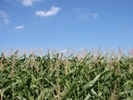July 25, 2010

Gabe Brown, Bismarck, N.D., has a breakeven price for corn of $1.18 per bushel.
His calculation includes the going rate for land rent in his area, the actual cost of herbicides, seed and other inputs; and the cost of field work based on standard custom rates. Family living expenses are not part of the formula
No-till, cover crops and cows are responsible for his low breakeven price.
Brown, who operates a 5,000 acre ranch near Bismarck (about half is cropland) has no-tilled and used cover crops extensively for a number of years. He plants cover crops to improve the biological activity in the soil. As a result, crop residue breaks down and turns into plant food more quickly, he says. Improved biological activity also helps plants take up nutrients.
Brown is also grazing cattle on cropland. Their manure and urine fertilize the soil. They also trample living and dead plant material into the soil, where it can be broken down and turned into nutrients for cash crops.
He and his son, Paul, use several intensive grazing methods – including mob grazing in the summer and bale grazing on cropland in the winter.
Their goal is to graze every acre of cropland.
"It really makes a difference," he says.
The Browns are able to produce high corn yields without any add commercial fertilizer.
You May Also Like




